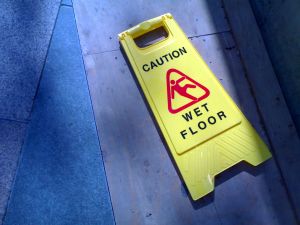Workers’ compensation appeals often involve extremely complex litigation to help claimants in need get appropriate benefits to which they are rightfully entitled. Benavides v. Eastern N.M. Med. Ctr., a case from the New Mexico Supreme Court, involved a claimant who was working as a registered nurse.
 Claimant slipped on a wet floor at the medical center and seriously injured her right leg, hip, lower back, and neck. She quickly applied for workers’ compensation benefits and was awarded around $580 per week as the maximum allowable benefit under a temporary total disability rating. This happened in 2006.
Claimant slipped on a wet floor at the medical center and seriously injured her right leg, hip, lower back, and neck. She quickly applied for workers’ compensation benefits and was awarded around $580 per week as the maximum allowable benefit under a temporary total disability rating. This happened in 2006.
As our Boston work injury attorneys can explain, claimants who apply for workers’ compensation are assigned a disability rating that determines total monthly benefits. Ratings can either be for a total or a partial disability and can be permanent or temporary. A temporary total disability rating means that a worker cannot work at all, but it is believed he or she will eventually heal and be able to return to work.
In 2011, Employer filed a complaint seeking a permanent disability rating and maximum medical improvement (MMI). MMI means that all feasible medical treatment has been provided, and the injury is not likely to get any better. This would permit no longer paying for medical treatment. Claimant filed counter arugment and also requested a 10 percent increase in benefits on grounds that employer had failed to supply a required safety device to prevent her injury. The safety device was a wet floor sign.
Employer denied her claim and requested an evidentiary hearing before a workers’ compensation judge. During the hearing, three witnesses testified, including claimant, the director of environmental services for employer, and another registered nurse. Director testified that he supplied wet floor signs to housekeeping, and it was company policy to place a sign before mopping and remove it after mopping. The other nurse testified that she also slipped that day but was not injured and saw no wet floor signs. She then requested housekeeping put a wet floor sign on the floor, so nobody would be injured. Trial court concluded that wet floor signs were safety devices and, even though they were not properly displayed that day, they were provided, so she was not entitled to additional relief under the relevant state statute.
Claimant appealed this decision, and the intermediary court of appeals affirmed trial court’s ruling. Claimant then filed an appeal before the state supreme court. In that final appeal, the court found that a wet floor sign is a safety device that warned of a specific danger and was required under the law.
Claimant asserted that it defies logic to believe that employer supplied the wet floor merely because it was on a housekeeping cart near the scene of the accident. She argued that supplying the sign meant that it had to be used where the floor was wet from being mopped. On this issue, the court concluded that in this context, “supplied” shall be construed to mean “used,” and merely purchasing a sign and creating a policy did not mean the device was supplied when it was not actually placed on the wet floor. The court found that worker was entitled to a ten percent increase, based upon employer’s failure to use a required safety device.
If you are injured on the job in Massachusetts, call Jeffrey Glassman Injury Lawyers for a free and confidential consultation to discuss your workers’ compensation claim: (617) 777-7777.
Additional Resources:
Benavides v. Eastern N.M. Med. Ctr, November 6, 2014, New Mexico Supreme Court
More Blog Entries:
U.S. Lags in Safety Protections for Temp Workers, June 23, 2014, Massachusetts Workers’ Compensation Lawyers Blog
 Massachusetts Workers Compensation Lawyers Blog
Massachusetts Workers Compensation Lawyers Blog

